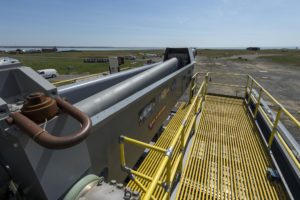
The Office of Naval Research (ONR)-sponsored Electromagnetic Railgun (EMRG) at terminal range located at the Naval Surface Warfare Center Dahlgren Division (NSWCDD). The EMRG launcher is a long-range weapon that fires projectiles using electricity instead of chemical propellants. (U.S. Navy photo by John F. Williams/Release)
The U.S. Navy has spent around $500 million in funding over the past decade for the research and development of its much-hyped electromagnetic railgun. The main obstacle to overcome was the massive 25 megawatts needed to power the weapon. That’s enough to power an average U.S. home for just over two years. It appears the U.S. Navy may have finally cracked that code as they are planning to test the railgun aboard surface warships, says Jared Keller of Task & Purpose.
After more than a decade of research and development and upwards of $500 million in funding, the Navy finally plans on testing its much-hyped electromagnetic railgun on a surface warship in a major milestone for the beleaguered weapons system, Navy documents reveal.
The Navy’s latest Northwest Training and Testing draft Supplemental Environmental Impact Assessment (NWTT EIS/OEIS), first detailed by the Seattle Times on Friday, reveals that ” the kinetic energy weapon (commonly referred to as the rail gun) will be tested aboard surface vessels, firing explosive and non-explosive projectiles at air- or sea-based targets.”
“The system charges for two minutes and fires in less than one second,” the 1,800-page assessment states. “The system is shielded so as not to affect shipboard controls and systems. The amount of electromagnetic energy released from this system is low and contained on the surface vessel.”
It’s unclear at this time exactly which vessel will play host to the new weapons system. Back in 2015, Naval Sea Systems Command had announced plans to test the railgun aboard the Spearhead-class expeditionary fast transport USNS Trenton (a substitute for the USNS Millinocket) off the coast of Florida in 2016, but that test was subsequently delayed.
The Navy has spent years test-firing the railgun at the Naval Surface Warfare Center Dahlgren Division in Virginia, but conducting a tactical demonstration of the weapon from an actual surface vessel would constitute a significant advance for the beleaguered system. Generating the railgun’s electromagnetic fields requires a capacitor base that only “electric warships” like the USS Zumwalt can currently generate, as Task & Purpose previously reported in December 2017, while other surface vessels would require a major overhaul to incorporate the “pulsed-power architecture” capable of loosing off multi-shot salvos.
While the Navy NWTT EIS/OEIS appears to indicate that service may have cracked the code for power generation, the success of the railgun is also contingent on the development of a universal “common mount” for equipping surface vessels with a tactical version of the ONR prototype. And as Task & Purpose also previously reported, that mount isn’t just a technical challenge, but a political one: a 2016 House Armed Services Committee report noted that lawmakers were increasingly worried that changing Pentagon priorities would end up nuking funding for a mount and resigning the system to an R&D limbo of sorts.
Read more here.
Steve Schneider
Latest posts by Steve Schneider (see all)
- New Chinese Electromagnetic Surveillance Leaves “Nowhere to Hide” on Battlefield - March 15, 2024
- Amazon’s Nuclear Powered Data Center - March 7, 2024
- Skunk Works Rolls Out An Engineering Marvel - March 6, 2024
- Future of Airpower Takes First Flight - March 4, 2024
- A War Beneath the Waves – Trillions of Dollars at Stake - February 9, 2024















